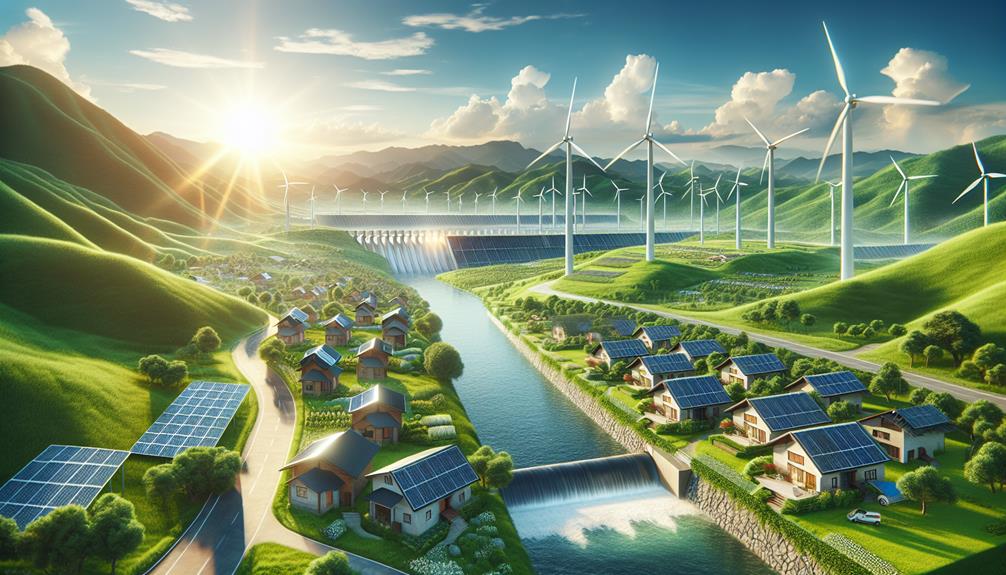What Green Energy Is The Best
When it comes to green energy, the options are plentiful. Solar energy, for instance, harnesses the power of the sun to generate electricity. Wind power, on the other hand, utilizes the force of the wind to produce energy. Hydropower, geothermal energy, and biomass energy are also viable sources of renewable energy.
What Green Energy Is The Best
But which one is the best? That's the question that often arises when discussing green energy. Each option has its own advantages and disadvantages, and the answer depends on various factors.
What Green Energy Is The Best
So, let's explore the different forms of green energy and weigh their pros and cons to determine which one truly reigns supreme.
What Green Energy Is The Best
Key Takeaways
What Green Energy Is The Best
- Solar energy is a sustainable and renewable source of power with no greenhouse gas emissions.
- Wind power is abundant, cost-effective, and has potential for significant growth.
- Hydropower provides reliable electricity but requires careful balancing of benefits and ecosystem protection.
- Geothermal energy is low in carbon emissions but limited to areas with accessible geothermal reservoirs.
- Biomass energy reduces greenhouse gas emissions but must be implemented sustainably to mitigate environmental concerns.
Solar Energy
What Green Energy Is The Best
Solar energy is a sustainable and renewable source of power that harnesses the sun's rays to generate electricity. When considering the advantages of solar energy, it's important to acknowledge its environmental benefits. Solar energy produces no greenhouse gas emissions during electricity generation, which helps combat climate change and reduce air pollution. Additionally, solar panels have a long lifespan and require minimal maintenance, making them a reliable and cost-effective option for energy production.
However, there are limitations to solar energy that must be acknowledged. One major limitation is its dependence on sunlight. Solar panels are most effective in regions with abundant sunshine, and their energy output may be reduced on cloudy or rainy days. Furthermore, the initial costs of installing solar panels can be high, although they're offset by long-term savings on electricity bills.
As for future advancements in solar technology, researchers are constantly working on improving the efficiency of solar panels and reducing their costs. One promising area of development is the use of advanced materials, such as perovskites, that have the potential to enhance the performance of solar cells. Additionally, energy storage technologies, such as batteries, are being developed to store excess solar energy for use during periods of low sunlight.
Wind Power
When considering alternative forms of renewable energy, another viable option to explore is wind power. Wind power harnesses the natural energy of the wind to generate electricity.
Here are some advantages of wind power:
- Renewable: Wind is an abundant resource that will never run out.
- Clean and Environmentally Friendly: Wind power produces no greenhouse gas emissions or air pollutants, making it a clean energy source.
- Cost Effective: Once a wind turbine is installed, the cost of generating electricity is relatively low, making it an economically viable option in the long run.
- Potential for Growth: Wind power has the potential for significant growth, as technology continues to improve and the demand for clean energy increases.
However, wind power also has some limitations:
- Intermittent: Wind isn't constant, and therefore, wind power production can fluctuate. This requires a backup energy source or energy storage system to ensure a steady supply of electricity.
- Land and Noise Requirements: Wind turbines require a significant amount of space and can produce noise, which can be a concern for nearby residents.
- Visual Impact: Some people may find wind turbines visually unappealing, especially in natural or scenic areas.
Hydropower
Hydropower, also known as hydroelectric power, utilizes the energy of flowing or falling water to generate electricity. When it comes to remote areas, hydropower has both benefits and drawbacks.
One major benefit is that it can provide a reliable and consistent source of electricity, even in areas far away from traditional power grids. This is especially important for remote communities that may not have access to other forms of energy.
Additionally, hydropower is a renewable energy source, meaning it doesn't deplete natural resources. However, there are drawbacks to consider as well.
The construction of hydropower plants can have a significant impact on aquatic ecosystems. Dams can disrupt the natural flow of rivers, affecting fish populations and their migration patterns. This can lead to a decline in biodiversity and harm the overall health of the ecosystem.
It's important to carefully assess the environmental impact before implementing hydropower projects in remote areas. Balancing the benefits of reliable electricity with the need to protect aquatic ecosystems is crucial for sustainable development.
Geothermal Energy
Geothermal energy, a renewable and sustainable source of power, harnesses the natural heat from the Earth's core to generate electricity. It offers several advantages that make it an attractive option for green energy production:
- Renewable and sustainable: Geothermal energy is derived from the Earth's natural heat, which is continually replenished. This makes it a reliable and long-term source of power.
- Low carbon emissions: Geothermal power plants produce minimal greenhouse gas emissions compared to fossil fuel-based power plants. This helps in reducing carbon footprints and combating climate change.
However, there are also limitations to consider when it comes to geothermal energy:
- Location-specific: Geothermal energy is only viable in areas with accessible geothermal reservoirs. This limits its widespread adoption and availability.
- High initial costs: Building geothermal power plants can be expensive due to the need for specialized drilling equipment and infrastructure. This can deter investment and slow down the development of geothermal projects.
Another application of geothermal energy is the use of geothermal heat pumps. These systems utilize the stable temperature of the ground to heat and cool buildings, providing energy-efficient climate control. Geothermal heat pumps offer advantages such as lower energy consumption, reduced carbon emissions, and long lifespan. However, they also have limitations, including high installation costs and the need for appropriate geological conditions.
Biomass Energy
Biomass energy, another viable option for green energy production, harnesses the power of organic matter to generate electricity. Biomass refers to any plant or animal material that can be used as fuel. It includes agricultural crops, wood pellets, animal waste, and even algae. Biomass energy has a wide range of applications, making it a versatile and accessible source of renewable energy.
One of the main advantages of biomass energy is its ability to reduce greenhouse gas emissions. When organic matter decomposes naturally, it releases methane, a potent greenhouse gas. By capturing and using this organic waste as biomass fuel, we can prevent methane emissions and reduce our carbon footprint. Biomass energy also offers an alternative to fossil fuels, reducing our dependence on non-renewable resources.
However, it's important to consider the environmental impact of biomass energy production. The cultivation of biomass crops can lead to deforestation and habitat destruction. Additionally, the burning of biomass for energy can release pollutants such as nitrogen oxides and particulate matter, which can have adverse effects on air quality.
To mitigate these concerns, sustainable practices must be implemented in biomass production and combustion. This includes using agricultural residues and waste materials instead of growing dedicated biomass crops, and implementing advanced emissions control technologies.
Conclusion
In the realm of green energy, each source brings its unique advantages and challenges.
Solar energy, like a radiant sunbeam, harnesses the power of sunlight, while wind power, like a gentle breeze, captures the force of the wind.
Hydropower, resembling a flowing river, utilizes the energy of water. Geothermal energy, like a hidden flame deep within the Earth, taps into its heat.
Lastly, biomass energy, akin to the cycle of life, transforms organic matter into power.
The best green energy source ultimately depends on the specific context and requirements.

